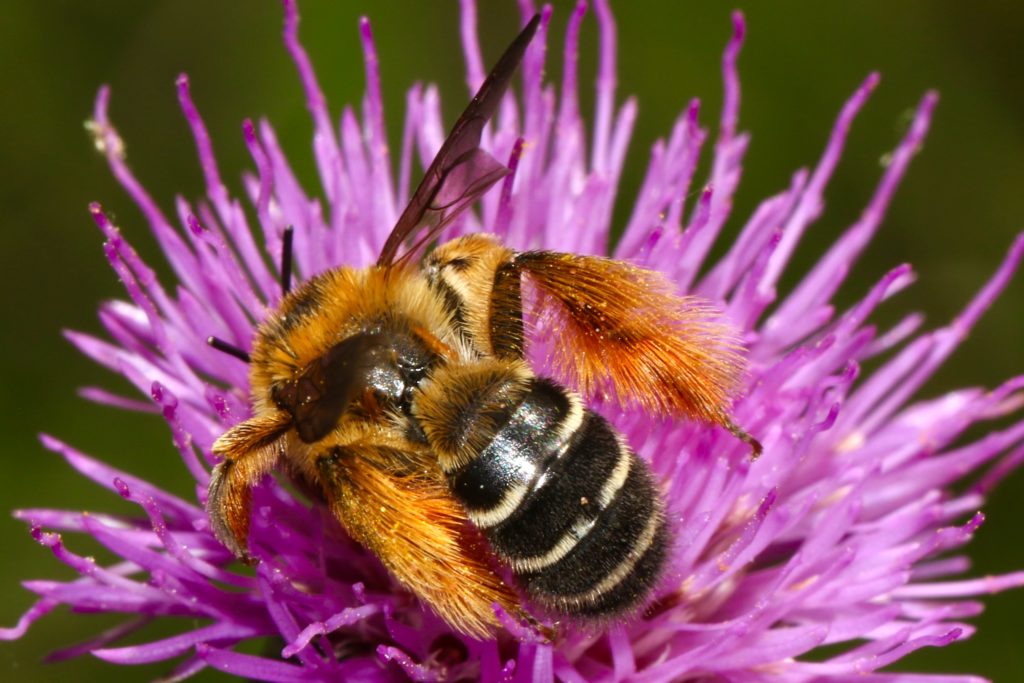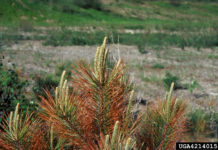Most people try and avoid anything with a stinger – bees, typically, are at the top of that list.
Others however, are of the opposite mindset: Erica Hoaglund, for example, a biologist with the Minnesota Department of Natural Resources (DNR) Nongame Wildlife Program, has dedicated her life seeking them out.
It is a warm sunny morning in October. Hoaglund and fellow biologist Luke Groff are on the hunt for the rusty patched bumble bee in Sand Dunes State Forest, near Zimmerman, Minnesota. The rusty patched bumble bee had recently received the distinct but dubious honor of being the first bumble bee placed on the federal list of endangered species. In response, states the bee have traditionally called home, like Minnesota, have started conducting surveys to get an idea of just how many are left. Groff had spotted one just a week earlier (which was the first documented sighting in modern times for Sherburne County) and the duo were out trying to confirm the bee’s presence by finding more.
Until the 1990’s, the rusty patched bumble bee had a territory spanning 28 states across the Midwest and New England, and Quebec, Ontario, and Washington, D.C. as well That territory, however is believed to have shrunk to just 13 states, about 10 percent of its historic range. Minnesota is one state thought to be one of their last strongholds, due to a variated mix of habitat types.
Multiple villains have been credited with the rusty patch’s decline in population. Biologists hav identified pesticides, pathogens, habitat loss, and climate change as possible factors. James Strange, a researcher in northern, Utah believes there may even be a parasitic fungus that causes the bees to bloat and grow so fast they are unable to reproduce. The increased presence of roadways throughout the bee’s habitat is also thought to be a contributor, as more cars means that more bees are struck and killed.
None of these theories, however, are conclusive. As Hoaglund admits, “We don’t completely know why. But we’re seeing huge declines and we think it’s likely these different factors are working together and magnifying each other.”

And it isn’t just the rusty patched bumble bee that has fallen on to hard times. Other species of bumble bees, as well as honey bees and other pollinators, have seen significant decline in population in recent years. The Xerces Society for Invertebrate Conservation has estimated that about a quarter of North American bumble bee species may be at risk of extinction. The situation is so dire that even our corporations are taking note – General Mills brought attention to the issue by removing Buzz the Bee from their signature Honey Nut Cheerios boxes for an extended period.
“Insects are the most diverse class of macro-organisms on this planet,” Hoaglund says. “But probably the one we know least about. If you’ve ever been stung by a bee, you might wonder why we’d worry about their survival. But if we don’t, our whole ecosystem could be in trouble, including ourselves.”
Bees are a huge part of the ecosystem as pollinators, responsible for helping produce one-third of all the food we eat as humans. Bumblebees specifically are unique for their size and strength, allowing them to engage in a form of pollination most other bees cannot: They perform what is known as “buzz pollination,” achieved by the rapid vibration of flight muscles while on a plant. This causes pollen to shake from the flower, and is a critical type of pollination for plants with flowers that don’t fully open, like tomatoes. A lack of bumblebees to contribute to the pollination of these plants might lead to what biologists refer to as “cascading effects” – the end of natural growth for many of our beloved fruits and vegetables, and a decline in the diversity of plants, insects, and other animals connected via their ecosystems.
The search for rusty patched bumble bees will, hopefully, provide answers to many of these questions. By learning about its habitat needs and preferences, biologists will better understand the decline in population and reverse it. The identifying of sites where they reside also allows for steps to be taken to provide site-specific protections to prevent further destruction.
The budget for the Minnesota Non-Game Wildlife Program is funded almost completely by donations. If you would like to know more about how to contribute, and contribute specifically via income tax or property tax forms, more information can be found at www.mndnr.gov. For more information about rare bumblebees, or if you have spotted one yourself, visit Bumble Bee Watch at www.bumblebeewatch.org – a citizen science effort to track and conserve North American bumble bees.
Read this next: New Wildlife Management Area in Dakota County

















